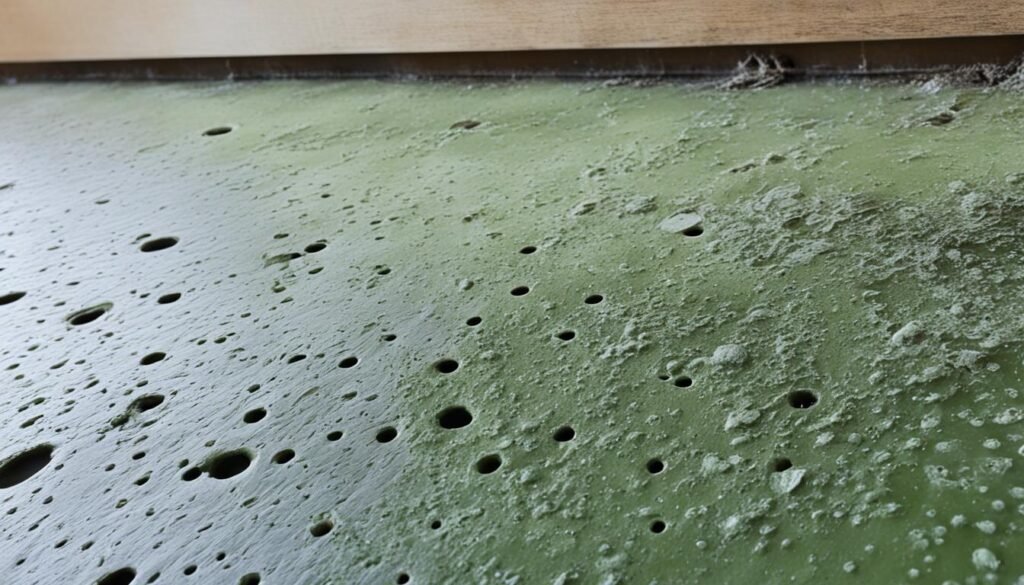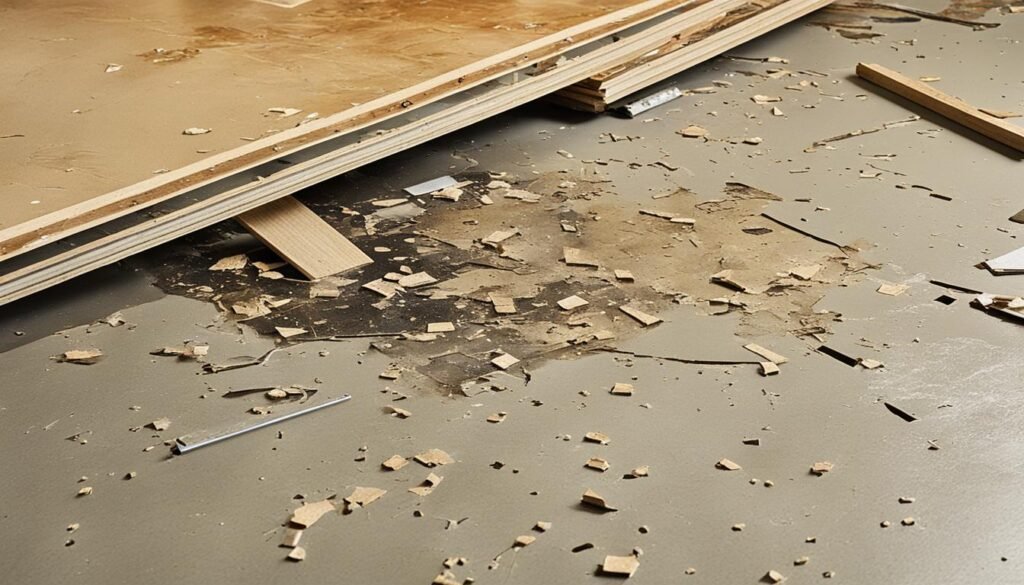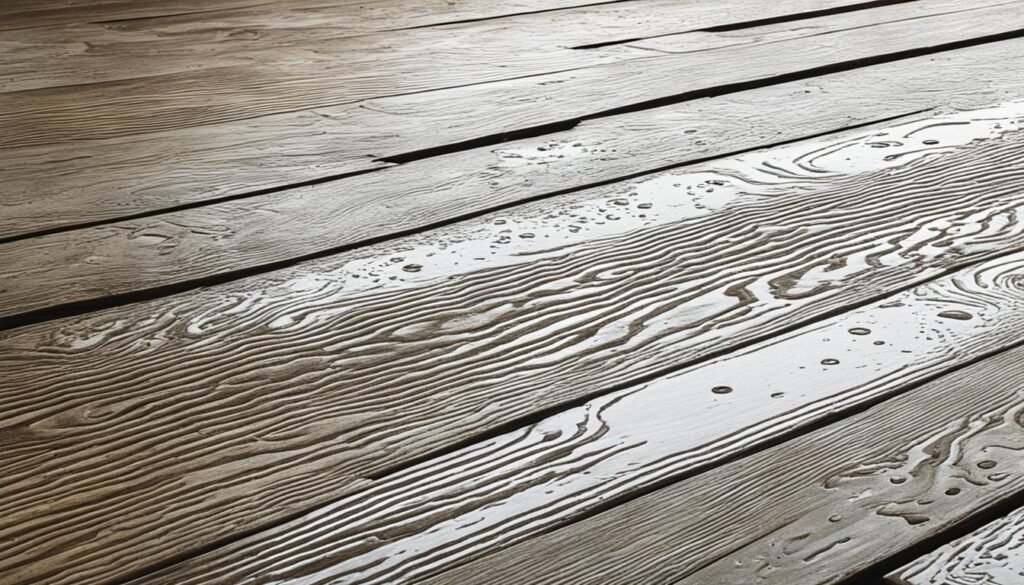Did you know that water damage to the subfloor is a big problem for many homeowners? It happens to over 14 million American homes every year, costing billions to fix. This damage can come from slow leaks, burst pipes, or storm flooding. If ignored, it can weaken your home’s structure and even cause mold to grow.
This guide will show you how to spot subfloor water damage, stop the water, and fix or replace the damaged area. Taking action early can save your home’s value and keep your family safe and comfortable.
Key Takeaways
- Subfloor water damage is a common and costly home repair issue, affecting over 14 million American homes each year.
- Neglecting subfloor water damage can compromise the structural integrity of your home and lead to mold growth.
- This guide covers the step-by-step process for identifying, stopping, and repairing subfloor water damage.
- Prompt action is crucial to prevent further damage and protect the value of your home.
- Addressing subfloor water damage involves stopping the water source, removing and replacing the damaged subfloor, reinforcing floor joists, and installing a new moisture barrier.
Signs of Subfloor Water Damage and How to Identify It
Subfloor water damage shows up in many ways. It’s key to spot these signs early. This way, you can fix it before it gets worse and costs more.
Spongy or Sagging Floors
A spongy or sagging floor is a clear sign of subfloor water damage. If your floors feel “soft” or not even, the subfloor might be rotting. Moisture makes the subfloor swell and lose its strength.
Warping, Bubbling, or Peeling Flooring
Warping, bubbling, or peeling floors also point to subfloor water damage. This can happen with hardwood, tile, or laminate floors. Water makes the subfloor swell or deform, causing the floor to look distorted.
Musty Odors Indicating Mold Growth
A musty or damp smell means there’s subfloor water damage. This smell comes from mold growing due to moisture in the subfloor. Mold not only weakens the subfloor but can also be harmful to health. So, it’s important to fix the problem fast.
By watching for these signs of subfloor water damage, you can act quickly. Fix the water issue, remove the damaged flooring, and repair or replace the subfloor. This keeps your home’s foundation strong.
How to Fix Subfloor Water Damage
Fixing subfloor water damage needs a step-by-step plan. This plan helps solve the problem and stops future issues. It includes stopping the water, removing flooring, and installing new subflooring.
Stop the Water Source
First, find and fix the water source. This could be a leak, a roof leak, or storm flooding. Once you’ve stopped the leak, you can move on to the next steps.
Remove the Flooring and Expose the Subfloor
Next, take out the flooring like carpet, hardwood, or tile. This lets you see the subfloor’s damage and decide on repairs.
Cut Out and Remove Damaged Subfloor
Look at the subfloor for damage, rot, or decay. Cut out and remove any damaged parts to stop further problems.
Reinforce Floor Joists if Needed
If the damage hit the floor joists, they might need reinforcement. This makes sure the floor is strong and safe for new subflooring.
Install New Subflooring
Finally, put in new subflooring. Use exterior-grade plywood or OSB. Make sure it’s installed right for a solid and even base for new flooring.
By doing these steps, you can fix subfloor water damage and make your home’s foundation strong again. Always be careful and think about getting a pro if the damage is big or you’re not sure what to do.

how to fix subfloor water damage
Fixing subfloor water damage is key to keeping your home strong. First, find and stop where the water is coming from. Then, take off the flooring to see how bad the damage is.
To fix subfloor water damage, follow these steps:
- Identify and Stop the Water Source: Find out why water is getting in, like a leak or too much ground moisture. Fixing this first helps stop more damage.
- Remove the Flooring: Take out the flooring, like hardwood or tile, to see the subfloor and check damage.
- Cut Out and Replace Damaged Subfloor: Find and remove any badly damaged subfloor parts. Use a jigsaw or saw for this.
- Reinforce Floor Joists (if Needed): If the damage hit the floor joists too, they might need fixing or replacing for safety.
- Install New Subflooring: Put in new subflooring that won’t get damaged by water. Use materials like plywood or OSB, and make sure they’re securely attached.
The cost to repair subfloor water damage depends on the size and how bad it is. But fixing it fast is important to avoid more problems and keep your home safe.

“Addressing subfloor water damage is essential for maintaining the structural integrity of your home.”
By doing these steps, you can fix subfloor water damage and make your home’s foundation strong and useful again. If the damage is big or you’re not sure what to do, get help from a professional.
Conclusion
Fixing subfloor water damage is key to keeping your home in good shape. Knowing the signs like spongy floors, warped flooring, and musty smells helps you act fast. This way, you can stop the damage before it gets worse.
To fix the damage, first, stop the water from coming in. Then, remove the flooring and replace the damaged subfloor. If needed, strengthen the floor joists and put in new subflooring. These steps help keep your floors strong and safe.
Whether it’s a small leak or a big flood, acting quickly is vital. Using the right materials and methods is also important for a good repair. By doing this, you keep your home safe and functional. Your home stays a cozy and secure place for many years.


